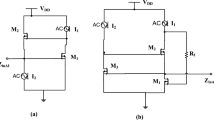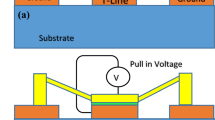Abstract
Active inductors circuits are developed as an alternative solution for multiband systems. In this context, this paper presents a wide tunability, a low power, high-Q differential active inductor (DAI) using 0.13 μm CMOS technology. This work proposes a DAI using two cascode-grounded active inductors and cross-coupled negative resistance to decrease the noise and to improve the quality factor. The inductance tuning range, quality factor, and other performance are improved by using a technique enabling to vary the current crossing the proposed circuit and by inserting a tunable feedback resistance. Results based on post-layout simulations (PLS) illustrate that the inductance tuning range from 79.8 to 495 nH resulting in a frequency tuning range from 3.19 to 0.784 GHz. An excellent tunable quality factor almost of 2600 is achieved at 1.47 GHz. The core DAI dissipates between 1.57 and 2.59 mW on a 1 V supply voltage. The circuit has an input 1 dB compression point Pin, 1 dB of −2.32 dBm. Simulated noise at 0.784 GHz is less than 3.48 nV/√Hz. The chip area of the DAI with testing pads is around 0.002 mm2.










Similar content being viewed by others
References
Ler, C., A’ain, B., Khari, A., et al. (2008). Compact, high-Q, and low-current dissipation CMOS differential active inductor. IEEE Microwave and Wireless Components Letters, 18(10), 683–685.
Yuan, F. (2008). CMOS active inductors and transformers principle, implementation, and applications. New York: Springer.
Wu, Y., Ding, X., Ismail, M., Olsson, H. (2003). RF band pass filter design based on CMOS active inductors. IEEE Transactions on Circuits and Systems II: Express Briefs, 50(12), 942–949.
Hara, S., Tokumitsu, T., Tanaka, T., Aikawa, M. (1988). Broad band monolithic microwave active inductor and its application to miniaturized wide band amplifiers. IEEE Transactions on Microwave Theory and Techniques, 36(12), 1920–1924.
Hara, S., Tokumitsu, T., Aikawa, M. (1989). Lossless broad band monolithic microwave active inductor. IEEE Transactions on Microwave Theory and Techniques, 13(12), 955–958.
Bakken, T., & Choma, J. (2003). Gyrator-based synthesis of active on-chip inductances. Analog Integrated Circuits and Signal Processing, 34(3), 171–181.
A. Thanachayanont, in Proceedings of the ICIT, CMOS transistor-only active inductors for IF/RF applications (IEEE, Thailand, 2002), pp. 1204–1212.
A. Thanachayanont and S. Ngow, in Proceedings of the MWSCAS, Class AB VHF CMOS active inductor (IEEE, Oklahoma, 2002), I - 64-7(1).
Yang, J., Fan, H., TSAI, P., et al., in Proceedings of the ISCIT, A RF CMOS low noise amplifier for WiMAX applications (IEEE, Incheon, 2009), pp. 958–962.
Zhenjie G., Wanrong Z., Hongyun X., Chunbao D., Zhiyi L., Guanghui X., Yujie Z., in Proceedings of the ICMMT, Improved quality-factor of cascode-grounded active inductor (IEEE, Shenzhen, 2012), pp. 1–3.
Chun-Lee, L. E. R., A’ain, B., Khari, A., et al. (2008). Compact, high-, and low-current dissipation CMOS differential active inductor. Microwave and Wireless Components Letters, IEEE, 18(10), 683–685.
Bhattacharya, R., Basu, A., Koul, S. K. (2015). A highly linear CMOS active inductor and its application in filters and power dividers. Microwave and Wireless Components Letters, IEEE, 25(11), 715–717.
Pandey, M., Canelas, A., Povoa, R., et al. (2015). Grounded active inductors design optimization for fQmax = 14.2 GHz using a 130 nm CMOS technology. In: Synthesis, Modeling, Analysis and Simulation Methods and Applications to Circuit Design (SMACD), 2015 International Conference on. IEEE. p. 1–4.
Abdalla, M. A. Y., Phang, K., Eleftheriades, G. V. (2007). Printed and integrated CMOS positive/negative refractive-index phase shifters using tunable active inductors. IEEE Transactions on Microwave Theory and Techniques, 55(8), 1611–1623.
A’ain, A., Kordesch, A. V., et al. (2009). CMOS active inductor linearity improvement using feed-forward current source technique. IEEE Transactions on Microwave Theory and Techniques, 57(8), 1915–1924.
Author information
Authors and Affiliations
Corresponding author
Rights and permissions
About this article
Cite this article
Hammadi, A.B., Mhiri, M., Haddad, F. et al. An Enhanced Design of RF Integrated Differential Active Inductor. BioNanoSci. 6, 185–192 (2016). https://doi.org/10.1007/s12668-016-0206-0
Published:
Issue Date:
DOI: https://doi.org/10.1007/s12668-016-0206-0




